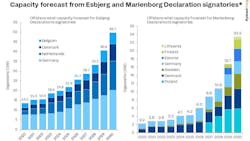Report: Denmark not quite on track to meet 2030 wind target
Offshore staff
OSLO, Norway — Rystad Energy said Denmark is one of the pioneers of offshore wind technology, leveraging its technical prowess with available acreage in the North Sea and Baltic Sea. It is now one of the five largest offshore wind markets in Europe, with further capacity additions likely in the coming decades to help meet Europe’s low-carbon power needs.
This year the Danish government set a new target to deploy 12.9 GW of offshore wind capacity by 2030, a 4-GW increase from the previous mark. It follows Denmark’s pledge to contribute to the Esbjerg Declaration alongside Germany, the Netherlands and Belgium. This aims for 65 GW of offshore wind to be installed by the four countries by 2030 and 150 GW by 2050.
The charts above illustrate the combined capacity forecast for these four countries only amounts to about 50 GW by 2030, with Denmark reaching some 9 GW by the same year, meaning that more additions will need to come online this decade, according to Rystad.
Denmark is also participating in the Marienborg Declaration via which eight countries in the Baltic Sea have committed to installing almost 20 GW of offshore wind capacity by 2030. Rystad Energy expects seven nations (excluding Latvia since the commissioning of an offshore wind farm there is unlikely before 2030) to surpass the 19.6-GW mark. The Marienborg Declaration has also been signed by Sweden and Finland, which are forecast to install a combined 6 GW of offshore wind capacity by 2030.
Recent news from Denmark
In late October, Ørsted and Copenhagen Infrastructure Partners agreed to jointly develop about 5.2 GW from four offshore wind projects in Denmark:
- Vikinge Banke (1.1 GW) in the North Sea;
- Jyske Banke Nord (1.1 GW) in the North Sea;
- Bornholm Bassin Syd (1.5 GW) in the Baltic Sea; and
- Bornholm Basin Øst (1.5 GW) in the Baltic Sea.
That same month the governments of Belgium and Denmark entered into an agreement that allows the carbon capture and storage Project Greensand to move forward. This will permit captured CO2 to be shipped across their boarders for permanent subsurface storage in a sandstone reservoir 1,800 m beneath the Danish North Sea.
From Aug. 22 to Sept. 26, the Danish Energy Agency invited citizens, companies, authorities and others with an interest in the future energy island in the North Sea to contribute with suggestions and ideas on topics that are to be elucidated in the environmental assessment of the plans for the energy island. The energy island's goal is to ensure Denmark can electrify more parts of society in a green way in the coming years and contribute to ensuring that the power consumption of all Danish households and companies is covered by green power.
11.16.2022
